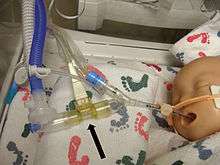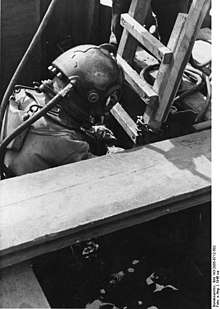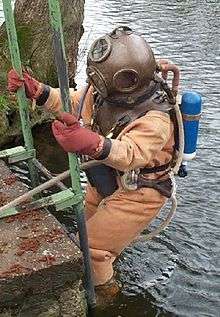Dräger (company)
Drägerwerk AG is a German company based in Lübeck[2] which makes breathing and protection equipment, gas detection and analysis systems, and noninvasive patient monitoring technologies.[3] Customers include hospitals, fire departments and diving companies.
 | |
| Kommanditgesellschaft auf Aktien with Aktiengesellschaft as partner with unlimited liability | |
| Traded as | FWB: DRW3 |
| ISIN | DE0005550636 |
| Industry | Engineering, medical technology |
| Founded | 1889 |
| Founder | J. Heinrich Dräger and Carl Adolf Gerling |
| Headquarters | Lübeck, Germany |
Key people | Stefan Dräger (CEO and chairman of the executive board), Nikolaus Schweickart (Chairman of the supervisory board) |
| Services | Diving equipment, rebreathers, SCBA, medical ventilators and monitors, anaesthetic machines, neonatal incubators, gas detectors, breathalyzers, drug testing equipment |
| Revenue | €2.78 billion (2019)[1] |
| €33.79 million (2019)[1] | |
| Total assets | €2.57 billion (2019)[1] |
| Total equity | €1.08 billion (2019)[1] |
Number of employees | 14,845 (2019)[1] |
| Website | www.draeger.com |
History
The company was founded in Lübeck in 1889 as Dräger & Gerling by J. Heinrich Dräger and Carl Adolf Gerling.[2] The first patent was taken out for a reduction device for using carbon dioxide to dispense beer. In 1902 Heinrich Dräger's son Bernhard entered the management; from then on, the company was named Drägerwerk Heinr. und Bernh. Dräger. Since 1970, Drägerwerk has been a public limited company, or Aktiengesellschaft (AG) in German.
In 2003, the aerospace division was sold to Cobham plc. In July 2006, it was announced that Draeger Aerospace GmbH had been acquired by B/E Aerospace, Inc.[4]
Draeger's stock tumbled to its lowest YTD close of 66.6 EU on 4/18/18. Its YTD high was 104.15 EU on 5/10/17. Stocks have been booming since the beginning of the COVID-19 pandemic.
Dräger Medical GmbH


Dräger Medical is a manufacturer of medical equipment. The company offers products and services including Emergency Care, Perioperative Care, Critical Care, Perinatal Care and Home Care. With headquarters in Lübeck, Germany, Dräger Medical employs nearly 14,000 people worldwide,[5] around half of whom work in customer sales & services. R&D and production are located in Lübeck, Germany; Best, Netherlands; Richmond Hill, ON, Canada; Telford, PA, USA; Andover, MA, USA; and Shanghai, China. The company has sales and service subsidiaries in almost 50 countries and is represented in more than 190 countries.
Dräger Safety GmbH
Dräger Safety GmbH is a manufacturer of personal protection and gas detection technology, and a supplier of safety systems for industry, fire prevention, mining and other hazardous areas.[6] The products and services from Dräger Safety warn and protect people from airborne pollutants and enable people to breathe reliably even in extreme situations.
Dräger claims to have longstanding experience, especially in the fields of gas management, gas flow control, gas monitoring and gas measurement. The current product range encompasses respiratory protective equipment for firefighters, miners and other industrial personnel as well as complete air filter and air supply systems, portable and fixed gas detection and warning systems, devices for on-site or laboratory contaminant analysis, and instruments to determine a person's breath-alcohol concentration.
Dräger combines the practical use of equipment with, for example, consultancy services, training, maintenance, service and commissioning. Represented in over 100 countries, the company has 40 subsidiaries and, with its 3,600 employees, achieved global sales of €557.8 million in 2005 (EBIT: €40.7 million). Dräger Safety operates production plants in Germany, Great Britain, USA, Sweden, South Africa and China.
Dräger Safety faces heavy competition from other manufacturers of safety equipment such as Sensidyne, LP. Also, the company's competitors include Mine Safety Appliances, Industrial Scientific Corporation and RAE Systems.[7]
Dräger supports the German Firefighting Sports Federation in the German firefighting fitness badge.[8]
Colorimetric gas detector tubes
Dräger was one of a few companies who were early pioneers of colorimetric gas detector tubes (also known as "detector tubes") used to measure the concentration of gases present. In a typical colorimetric gas detector tube a known volume of air is pumped through a tube using a pump. The tube typically has a layer which indicates the analyte by changing colour, depending on the amount of the gas which has passed through the tube the length of the zone which has changed colour will be different.[9][10] Today colorimetric gas detector tubes are used throughout industry as a low-cost and easy-to-use tool for detecting the presence of gases and are available from a wide range of manufacturers.
An early limitation of detector tubes is that they were designed to detect a single known gas or vapor. Advancements in the design and capability of detector tubes came with the introduction of such tools as the HazMat kit. The specialty kits are designed for use by hazardous material response teams in determining what gases or vapors are present through using a "stack" of colorimetric material that change color based upon the presence of an organic or inorganic gas.
Alcohol Screening Kits
Dräger developed their first Alcohol screening kit in 1953 when some employees came into work hungover following a party the night before. It was originally developed using silicon crystals, where a breath sample was passed through these silicon crystals, if there was alcohol in this breath sample, a chemical reaction would occur resulting in the crystals changing colour. This particular method is still used today to create "single use breathalyzers."
Dräger's first digital display Alcohol Screening Kit was developed in 1980. Later they developed a breathalyzer that uses a fuel sensor. Many of Drägers breathalyzers have home office approval, which means they can be used by the police in a variety of countries, including the UK.
Diving equipment


In 1912 Drägerwerk developed standard diving dress which did not need surface supplied breathing gas via a diver's umbilical, as it used a self contained gas supply came from a rebreather. Two versions were available, one for oxygen to 20 metres, and the other for nitrox to 40 metres. The semi-closed circuit used the injected gas to circulate the gas in the helmet through a scrubber, providing a very low work of breathing in comparison with most other rebreathers which used the lungs of the diver to circulate gas in the loop. The bubikopf helmet was designed for use with this system. The rebreather loop hoses connected to the back of the helmet below the overhanging part, and led from there to the back-mounted scrubber.
Since 1941 Hans Hass used bag-on-back rebreathers for scuba diving, originally built by Dräger for self-rescue of submarine crews (Tauchretter; like the Davis Escape Set). The first Dräger-Tauchretter had been built in 1907. In 1926 the Bade-Tauchretter was brought into service for rescuing drowning swimmers.[11]
Dräger manufactured the popular Atlantis, Ray and Dolphin line of sport diving semi-closed-circuit nitrox rebreathers. It also makes the LAR-5 and LAR-6 military oxygen rebreathers, and the LAV-7 military rebreather which is switchable between closed-circuit and semi-closed-circuit.[12][13]
Dräger made the high-altitude oxygen sets used by the 1952 Swiss Mount Everest expedition (the second (autumn) expedition), and John Hunt was able to have adaptors made so that the 1953 British expedition could use oxygen from tanks the Swiss had left behind, particularly for their "sleeping sets"; see bottled oxygen.[14]
See also
- Rebreather – Apparatus to recycle breathing gas
References
- "ANNUAL REPORT 2019" (PDF). Dräger. Retrieved 22 March 2020.
- ChemEurope. "Drägerwerk AG & Co. KGaA." Retrieved Feb 13, 2013.
- Bloomberg Businessweek. "Draegerwerk Ag - Pref (DRW3:Xetra)." Retrieved Feb 13, 2013.
- B/E Aerospace Announces the Acquisition of Draeger Aerospace GmbH
- Peter Cebon. "Measured Success." Retrieved Apr 18, 2013.
- http://www.process.vogel.de/Dr-C3-A4ger-Safety-AG-Co-KGaA/firma/197131
- Wikinvest. "Competition Archived 2014-08-08 at the Wayback Machine". Retrieved Apr 26, 2013.
- http://www.dfs-ev.de/index.php?page=dffa
- "Archived copy" (PDF). Archived from the original (PDF) on 2012-05-24. Retrieved 2012-06-30.CS1 maint: archived copy as title (link)
- "Dräger in Russia". Retrieved 2013-07-19.
- Quick, D. (1970). "A History Of Closed Circuit Oxygen Underwater Breathing Apparatus". Royal Australian Navy, School of Underwater Medicine. RANSUM-1-70. Retrieved 2009-03-20.
- Goble, Steve (2003). "Rebreathers". South Pacific Underwater Medicine Society Journal. 33 (2): 98–102. Archived from the original on 2009-08-08. Retrieved 2009-03-20.
- Images.
- Hunt, John (1953). The Ascent of Everest. London: Hodder & Stoughton. pp. 51, 52, 130, 137, 173.
External links
| Wikimedia Commons has media related to Drägerwerk. |